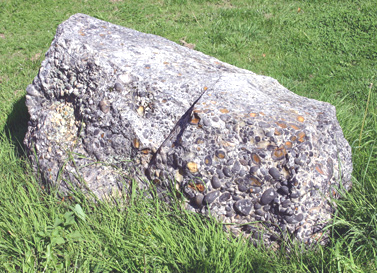Hertfordshire Puddingstone is largely confined to the English
county of Hertfordshire. Superficially, it resembles concrete, but
it is entirely natural. Geologically this type of rock is known as
a conglomerate, which means it's composed of pebbles of an earlier
rock type incorporated into finer sediment, in this case mainly
quartz sand. The pebbles in it are flints derived from the
underlying chalk which have been rounded by continually being
carried along in a river.

The unusual thing about Hertfordshire Puddingstone is that the
pebbles have been cemented together with silica, which is a very
hard material. This silica has been drawn out of the underlying
rock by water percolating from the surface of the earth downwards.
When the traveling silica found this accumulation of pebbles and
sand on its way down, it was re-deposited as a fine material which
invaded all the little pores between the pebbles and the sand
particles and stuck them all together. The process is typical of
tropical regions, so it must date back to when the climate in this
part of the world was something near tropical - very different from
today's Hertfordshire weather!
If you look at a cross section of the rock, you will see a range
of very attractive colours including bright yellows, browns and
bright reds. The pebbles very often have black exteriors which show
as rinds when the pebbles are viewed in cross sections on cut
surfaces. From a greater distance, puddingstone is generally brown
or ginger in colour, although pink is possible.
Puddingstone may look like concrete, which is made from stone
fragments ('aggregate') in a matrix of Portland cement. For the
‘aggregate’ component, flint pebbles, mechanically sorted from
local gravels, are often used, and so concrete and Hertfordshire
Puddingstone can be easy to confuse. However there are the
following differences: 1. In concrete the matrix material will be
opaque white, in puddingstone variations of pale brown and grey; 2.
The fine-grained concrete matrix is softer than the pebbles, and
can be scratched with a penknife; 3. Concrete breaks irregularly,
not smoothly across matrix and pebbles, as Hertfordshire
Puddingstone usually does.
Hertfordshire puddingstone was credited in local folklore with
several supernatural powers, including being a protective charm
against witchcraft. Parish records from the village of Aldenham
relate that in 1662 a woman suspected of having been a witch was
buried with a piece of it laid on top of her coffin to prevent her
from escaping after burial. The romans used this hard stone to make
grindstones to grind corn.
The GPS co-ordinates will take you to a large lump of
Hertfordshire Puddingstone in the churchyard of the church of Saint
John the Baptist in Great Gaddesden. This is just one of several
lumps. Puddingstone is built into the foundations of the 800 year
old church - the vicar told me that she at first thought it was
concrete and was puzzled by how it got there! If you look at the
flint walls of the church you will quickly spot many lumps of
colourful Puddingstone built into the walls amongst the flints all
round the church.
Please park considerately when visiting this church, and
treat the area with respect, especially on a Sunday when services
may be going on during your visit.
In order to complete this cache you must perform a series of
tasks and answer some questions and mail them to me through my
geocaching profile:
1) Take a photo of yourself with the main lump of
puddingstone.
2) One cubic foot (12 x 12 x 12 inches) of Hertfordshire
Puddingstone weighs approximately 0.05 tons. Please estimate the
weight of this lump.
3) What geological time period does Hertfordshire
Puddingstone date from and how many millions years ago was
this?
4) What is it that gives the flints their reddish
colour?